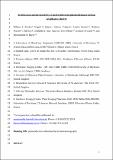Files in this item
Architecture and permeability of post-cytokinesis plasmodesmata lacking cytoplasmic sleeves
Item metadata
| dc.contributor.author | Nicolas, William J. | |
| dc.contributor.author | Grison, Magali S. | |
| dc.contributor.author | Trépout, Sylvain | |
| dc.contributor.author | Gaston, Amélia | |
| dc.contributor.author | Fouché, Mathieu | |
| dc.contributor.author | Cordelières, Fabrice P. | |
| dc.contributor.author | Oparka, Karl | |
| dc.contributor.author | Tilsner, Jens | |
| dc.contributor.author | Brocard, Lysiane | |
| dc.contributor.author | Bayer, Emmanuelle M. | |
| dc.date.accessioned | 2017-12-13T00:32:22Z | |
| dc.date.available | 2017-12-13T00:32:22Z | |
| dc.date.issued | 2017-07-01 | |
| dc.identifier | 250365384 | |
| dc.identifier | f9dc491a-951d-4aa0-a8ac-26ef8f1f7372 | |
| dc.identifier | 85020721414 | |
| dc.identifier | 000406037200012 | |
| dc.identifier.citation | Nicolas , W J , Grison , M S , Trépout , S , Gaston , A , Fouché , M , Cordelières , F P , Oparka , K , Tilsner , J , Brocard , L & Bayer , E M 2017 , ' Architecture and permeability of post-cytokinesis plasmodesmata lacking cytoplasmic sleeves ' , Nature Plants , vol. 3 , no. 7 , 17082 . https://doi.org/10.1038/nplants.2017.82 | en |
| dc.identifier.issn | 2055-026X | |
| dc.identifier.other | ORCID: /0000-0003-3873-0650/work/60630833 | |
| dc.identifier.uri | https://hdl.handle.net/10023/12323 | |
| dc.description | This work was supported by the grants by the Region Aquitaine (to E.M.B) and PEPS (Initial Support for Exploratory Projects to E.M.B) and National Agency for Research (Grant ANR-14-CE19-0006-01 to E.M.B). | en |
| dc.description.abstract | Plasmodesmata are remarkable cellular machines responsible for the controlled exchange of proteins, small RNAs and signalling molecules between cells. They are lined by the plasma membrane (PM), contain a strand of tubular endoplasmic reticulum (ER), and the space between these two membranes is thought to control plasmodesmata permeability. Here, we have reconstructed plasmodesmata three-dimensional (3D) ultrastructure with an unprecedented level of 3D information using electron tomography. We show that within plasmodesmata, ER-PM contact sites undergo substantial remodelling events during cell differentiation. Instead of being open pores, post-cytokinesis plasmodesmata present such intimate ER-PM contact along the entire length of the pores that no intermembrane gap is visible. Later on, during cell expansion, the plasmodesmata pore widens and the two membranes separate, leaving a cytosolic sleeve spanned by tethers whose presence correlates with the appearance of the intermembrane gap. Surprisingly, the post-cytokinesis plasmodesmata allow diffusion of macromolecules despite the apparent lack of an open cytoplasmic sleeve, forcing the reassessment of the mechanisms that control plant cell-cell communication. | |
| dc.format.extent | 88274487 | |
| dc.language.iso | eng | |
| dc.relation.ispartof | Nature Plants | en |
| dc.subject | QH301 Biology | en |
| dc.subject | Plant Science | en |
| dc.subject | NDAS | en |
| dc.subject | BDC | en |
| dc.subject | R2C | en |
| dc.subject.lcc | QH301 | en |
| dc.title | Architecture and permeability of post-cytokinesis plasmodesmata lacking cytoplasmic sleeves | en |
| dc.type | Journal article | en |
| dc.contributor.institution | University of St Andrews. School of Biology | en |
| dc.contributor.institution | University of St Andrews. Biomedical Sciences Research Complex | en |
| dc.identifier.doi | 10.1038/nplants.2017.82 | |
| dc.description.status | Peer reviewed | en |
| dc.date.embargoedUntil | 2017-12-12 |
This item appears in the following Collection(s)
Items in the St Andrews Research Repository are protected by copyright, with all rights reserved, unless otherwise indicated.

